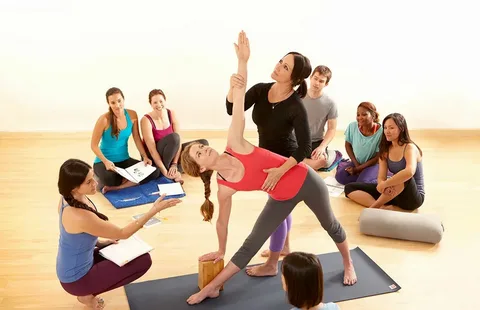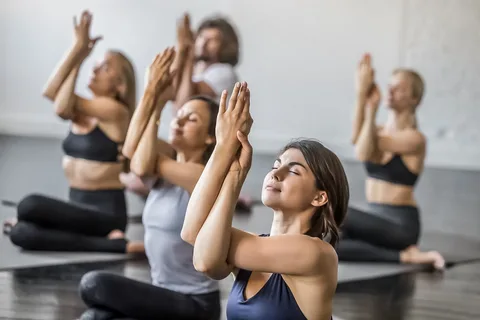In a world where stress, anxiety, and physical discomfort are becoming increasingly prevalent, finding effective methods for holistic well-being is more important than ever. Somatic Yoga, a unique blend of traditional yoga and body awareness techniques, offers a transformative approach to health and wellness. This practice emphasizes the connection between body and mind, fostering a deeper awareness of oneself and promoting overall healing.

What is Somatic Yoga?
Somatic Yoga is a modern interpretation of classical yoga that integrates principles from somatic therapy—a practice that focuses on the internal experience of the body. Unlike traditional yoga, which often emphasizes physical postures and alignment, Somatic Yoga places greater importance on internal sensations and the body’s inherent wisdom.
The term “somatic” comes from the Greek word “soma,” which means “body.” Somatic practices aim to cultivate a deeper connection with the body, facilitating greater awareness and self-understanding. In Somatic Yoga, this involves gentle movements, breathwork, and mindfulness techniques designed to enhance body awareness and promote relaxation.
The Core Principles of Somatic Yoga
1. Mind-Body Connection: At the heart of Somatic Yoga is the emphasis on the mind-body connection. This practice encourages individuals to tune into their physical sensations and emotional states, fostering a more profound awareness of how their bodies feel and function.
2. Sensory Awareness: Somatic Yoga techniques involve focusing on sensory experiences. By paying close attention to how movements feel and how the body responds, practitioners can develop a greater understanding of their physical and emotional states.
3. Gentle Movement: Unlike more vigorous forms of yoga, Somatic Yoga often incorporates slow, mindful movements. These movements are designed to help individuals release tension, improve flexibility, and increase body awareness.
4. Breathwork: Breathwork is a key component of Somatic Yoga. By integrating conscious breathing techniques, practitioners can enhance their overall sense of relaxation and well-being.
5. Mindfulness and Relaxation: Somatic Yoga encourages mindfulness through practices such as meditation and relaxation techniques. These practices help individuals stay present in the moment and reduce stress.
The Benefits of Somatic Yoga
1. Enhanced Body Awareness: By focusing on internal sensations, Somatic Yoga helps individuals become more aware of their body’s needs and responses. This heightened awareness can lead to improved posture, greater flexibility, and a deeper understanding of one’s physical and emotional states.
2. Stress Reduction: The mindful nature of Somatic Yoga helps activate the parasympathetic nervous system, which is responsible for the body’s relaxation response. This can lead to a reduction in stress levels and an increased sense of calm.
3. Improved Emotional Well-Being: The practice of Somatic Yoga can help individuals process and release emotional tension stored in the body. This can lead to improved emotional well-being and a greater sense of inner peace.
4. Pain Relief: For individuals experiencing chronic pain or discomfort, Somatic Yoga can offer relief by promoting relaxation and reducing muscle tension. The gentle movements and breathwork can help alleviate physical pain and improve overall comfort.
5. Increased Mindfulness: By incorporating mindfulness techniques, Somatic Yoga encourages individuals to stay present and aware. This can lead to improved focus, better emotional regulation, and a more balanced approach to life.
How to Practice Somatic Yoga
1. Find a Quiet Space: Choose a calm and quiet environment where you can practice without distractions. This will help you focus on your body and breath.
2. Start with Gentle Movements: Begin with slow, gentle movements that allow you to tune into your body. Focus on how each movement feels and adjust as needed.
3. Incorporate Breathwork: Integrate conscious breathing techniques into your practice. Pay attention to your breath and use it to guide your movements and enhance relaxation.
4. Practice Mindfulness: Incorporate mindfulness techniques such as meditation or body scans into your practice. This will help you stay present and connected to your body.
5. Listen to Your Body: Pay close attention to how your body feels and responds to each movement. Adjust your practice as needed to ensure that you are comfortable and relaxed.

FAQs:
1. What is the difference between Somatic Yoga and traditional yoga?
Somatic Yoga focuses more on internal body awareness and mindfulness rather than external postures and alignment. While traditional yoga often emphasizes physical poses and flexibility, Somatic Yoga prioritizes the sensory experience of movement and the connection between body and mind.
2. Do I need previous yoga experience to start Somatic Yoga?
No, Somatic Yoga is accessible to practitioners of all levels, including beginners. The practice is designed to be gentle and adaptable, making it suitable for individuals with varying levels of experience and physical abilities.
3. How often should I practice Somatic Yoga to see benefits?
The frequency of practice can vary depending on individual goals and needs. Many practitioners find that practicing Somatic Yoga a few times a week can yield significant benefits. Consistency is key to experiencing the full range of physical and emotional benefits.
4. Can Somatic Yoga help with chronic pain or injuries?
Somatic Yoga can be beneficial for managing chronic pain and injuries by promoting relaxation and reducing muscle tension. However, it is important to consult with a healthcare professional or a qualified yoga therapist to ensure that the practice is appropriate for your specific condition.
5. What should I wear for Somatic Yoga practice?
Wear comfortable, loose-fitting clothing that allows for ease of movement. Avoid restrictive clothing that may hinder your ability to focus on your body and breath.
6. Can Somatic Yoga be practiced alongside other forms of exercise?
Yes, Somatic Yoga can complement other forms of exercise by enhancing body awareness and promoting relaxation. It can be integrated into a well-rounded fitness routine to support overall well-being and improve physical and emotional balance.
7. Are there any specific breathing techniques used in Somatic Yoga?
Somatic Yoga often incorporates various breathing techniques, such as deep diaphragmatic breathing and paced breathing. These techniques help regulate the nervous system, promote relaxation, and enhance the overall practice.
